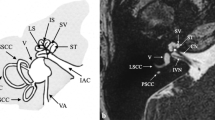Abstract
Objective
Chiari Malformation type I nowadays represents one of the most debated and treated entities of neurosurgery. Several different symptoms of cerebellar, brainstem and spinal cord pathology have been described and attributed to this malformation. In this paper, we reported a very uncommon association of Chiari I malformation with isolated hemihypertrophy in one case and clawing hands in the second case.
Case reports
We report the first case of a 14-year-old girl who presented with a 6-month history of left claw hand, with no evidence of radiculopathy and myopathy; MRI scan revealed a symmetrical herniation of cerebellar tonsils to the level of C1 (0.7 mm), downward displacement of the obex and holocord syrinx. We assisted to the complete resolution of the left clawing hand immediately after decompressive craniectomy, C1 laminectomy, opening of the dura and collagen matrix duraplasty. The second case is a 9-year-old boy who presented with hemihypertrophy affecting the left arm and chest wall, without involvement of the face.
Conclusions
These case reports can suggest the association of hemihypertrophy and claw hand with Chiari I malformation and syringomyelia. Further studies are necessary to assess the real incidence of focal motor deficits and mesodermic disorders in Chiari I malformation in order to clarify their pathogenetical mechanisms.


Similar content being viewed by others
References
Badie B, Mendoza BA, Batzdorf U (1995) Posterior fossa volume and response to suboccipital decompression in patients with Chiari I malformation. Neurosurgery 37:214–218
Bains RS, Althausen PL, Gitlin GN, Gupta MC, Benson DR (1976) The role of acute decompression and restoration of spinal alignment in the prevention of post-traumatic syringomyelia: case report and review of recent literature. Spine 26:E399–E402
Caldemeyer KS, Boaz JC, Wappner RS, Moran CC, Smith RR, Quets JP (1995) Chiari I malformation: association with hypophosphatemic rickets and MR imaging appearance. Radiology 195:733–738
Chitayat D, Rothchild A, Ling E, Friedman JM, Couch RM, Yong SL, Baldwin VJ, Hall JG (1990) Apparent postnatal onset of some manifestations of the Wiedemann–Beckwith syndrome. Am J Med Genet 36:434–439
Happle R (1986) Cutaneous manifestation of lethal genes. Hum Genet 72:280
Jaubert J, Jaubert F, Martin N, Washburn LL, Lee BK, Eicher EM, Guenet JL (1999) Three new allelic mouse mutations that cause skeletal overgrowth involve the natriuretic peptide receptor C gene (Npr3). Proc Natl Acad Sci USA 96:10278–10283
Lapresle J, Métreau R, Risvegliato M (1976) Segmental muscular hypertrophy in Arnold Chiari deformity associated with syringomyelia syndrome (article in French). Rev Neurol 132:567–570
Malaviya GN (1991) Correction of claw fingers in leprosy—current status. Acta Leprol 7:389–395
McGirt MJ, Attenello FJ, Atiba A, Garces-Ambrossi G, Datoo G, Weingart JD, Carson B, Jallo GI (2008) Symptom recurrence after suboccipital decompression for pediatric Chiari I malformation: analysis of 256 consecutive cases. Childs Nerv Syst 24:1333–1339
Menezes AH, Greenlee JD, Donovan KA (2005) Honored guest presentation: lifetime experiences and where we are going: Chiari I with syringohydromyelia—controversies and development of decision trees. Clin Neurosurg 52:297–305
Mesiwala AH, Shaffrey CI, Gruss JS, Ellenbogen RG (2001) Atypical hemifacial microsomia associated to Chiari I malformation and syrinx: further evidence indicating that Chiari I malformation is a disorder of the paraxial mesoderm. Case report and review of the literature. J Neurosurg 95:1034–1039
Milhorat TH, Chou MW, Trinidad EM, Kula RW, Mandell M, Wolpert C, Speer MC (1999) Chiari I malformation redefined: clinical and radiographic findings for 364 symptomatic patients. Neurosurgery 44:1005–1017
Neiman R, Maiocco B, Deeney VF (1998) Ulnar nerve injury after closed forearm fractures in children. J Pediatr Orthop 18:683–685
Nishikawa M, Sakamoto H, Hakuba A, Nakanishi N, Inoue Y (1997) Pathogenesis of Chiari malformation: a morphometric study of the posterior cranial fossa. J Neurosurgery 86:40–47
Novegno F, Caldarelli M, Massa A, Chieffo D, Massimi L, Pettorini B, Tamburrini G, Di Rocco C (2008) The natural history of the Chiari type I anomaly. J Neurosurg Pediatr 2:179–187
Paquis P, Lonjon M, Brunet M, Lambert JC, Grellier P (1998) Chiari Type I malformation and syringomyelia in unrelated patients with blepharophimosis. Report of two cases. J Neurosurg 89:835–838
Pareyson D, Marchesi C (2009) Diagnosis, natural history, and management of Charcot–Marie–Tooth disease. Lancet Neurol 8:654–667
Park JK, Gleason PL, Madsen JR, Goumnerova LC, Scott RM (1997) Presentation and management of Chiari I malformation in children. Pediatr Neurosurg 26:190–196
Robledo RF, Rajan L, Li X, Lufkin T (2002) The Dlx 5 and Dlx6 homeobox genes are essential for craniofacial, axial, and appendicular skeletal development. Genes Dev 1:1089–1101
Rowe NH (1962) Hemifacial hypertrophy. Review of the literature and addition of four cases. Oral Surg Oral Med Oral Pathol 15:572–587
Shenoy SN, Raja A (2005) Cystic cervical intramedullary schwannoma with syringomyelia. Neurology India 53:224–225
Steinbok P (2004) Clinical features of Chiari I malformations. Childs Nerv Syst 20:329–331
Sze RW, Gruss JS, Cunningham ML (2001) Unilateral aplasia of the middle cranial fossa floor in atypical hemifacial microsomia. Am J Neuroradiol 22:1434–1437
Tubbs RS, Smyth MD, Wellons JC III, Oakes WJ (2003) Hemihypertrophy and the Chiari I malformation. Pediatr Neurosurgery 38:258–261
Tubbs RS, McGirt MJ, Oakes WJ (2003) Surgical experience in 130 pediatric patients with Chiari I malformations. J Neurosurg 99:291–296
Tubbs RS, Oakes WJ (2005) Beckwith–Wiedemann syndrome in a child with Chiari I malformation. J Neurosurg 103(2 Suppl):172–174
Author information
Authors and Affiliations
Corresponding author
Rights and permissions
About this article
Cite this article
Pettorini, B.L., Oesman, C. & Magdum, S. New presenting symptoms of Chiari I malformation: report of two cases. Childs Nerv Syst 26, 399–402 (2010). https://doi.org/10.1007/s00381-009-1043-z
Received:
Published:
Issue Date:
DOI: https://doi.org/10.1007/s00381-009-1043-z




